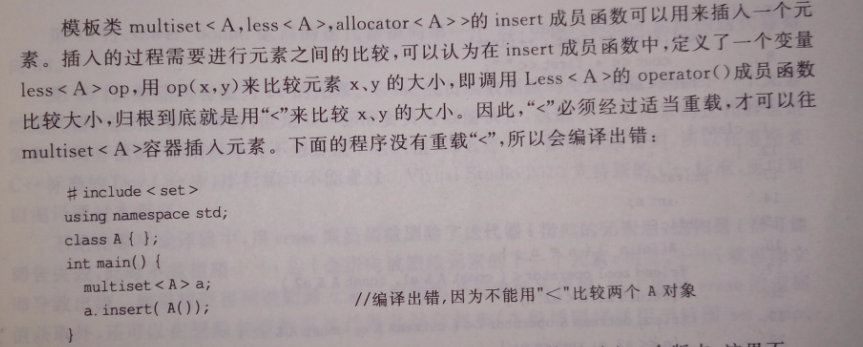使用必须包含头文件set
1)multiset
*:定义

如果不给第二个参数,默认less<key>,即用<来进行。
例如:
A是一个类的名字,则可以定义一个容器对象如下:
multiset<A>s;
由于multiset 的类型参数可以默认,所以上面的语句等价于:
multiset<int, less<A>,allocator<A>s>;

**:multiset的成员函数

find和count并不是通过==来进行比较值是否相等。它们的比较原则是x<y和y<x同时为假。
3)例
//program 19.4.2.1.cpp multiset的用法 #include <iostream> #include <set> //使用multiset须包含此文件 using namespace std; template <class T> void Print(T first, T last) { for(;first != last ; ++first) cout << * first << " "; cout << endl; } class A { private: int n; public: A(int n_ ) { n = n_; } friend bool operator< ( const A & a1, const A & a2 ) { return a1.n < a2.n; } friend ostream & operator<< ( ostream & o, const A & a2 ) { o << a2.n; return o; } friend class MyLess; }; class MyLess { public: bool operator()( const A & a1, const A & a2) //按个位数比大小 { return ( a1.n % 10 ) < (a2.n % 10); } }; typedef multiset<A> MSET1; //MSET1用 "<"比较大小 typedef multiset<A,MyLess> MSET2; //MSET2用 MyLess::operator()比较大小 int main() { const int SIZE = 6; A a[SIZE] = { 4,22,19,8,33,40 }; MSET1 m1; m1.insert(a,a+SIZE); m1.insert(22); cout << "1) " << m1.count(22) << endl; //输出1) 2 cout << "2) "; Print(m1.begin(),m1.end()); //输出 2) 4 8 19 22 22 33 40 MSET1::iterator pp = m1.find(19); if( pp != m1.end() ) //条件为真说明找到 cout << "found" << endl; //本行会被执行,输出 found cout << "3) "; cout << * m1.lower_bound(22) << "," <<* m1.upper_bound(22)<< endl; //输出 3) 22,33 pp = m1.erase(m1.lower_bound(22),m1.upper_bound(22));//pp指向被删元素的下一个元素 cout << "4) "; Print(m1.begin(),m1.end()); //输出 4) 4 8 19 33 40 cout << "5) "; cout << * pp << endl; //输出 5) 33 MSET2 m2; // m2里的元素按n的个位数从小到大排 m2.insert(a,a+SIZE); cout << "6) "; Print(m2.begin(),m2.end()); //输出 6) 40 22 33 4 8 19 return 0; }
2)set
*:定义
template<class Key, class Pred=less<Key>,class A=allocator<Key>
class set {....}
set和multiset相似,差别在于set中不能有重复元素。multiset的成员函数set也有,但由于没有重复元素,所以set中插入单个元素的insert成员函数和multiset不同,其原型如下,返回一个pair模板类的对象。
pair<iterator,bool>insert(const T & val);
假如set的insert成员函数的返回值是对象x,那么x.second为ture,则说明插入成功,此时x.first指向被插入元素的迭代器;x.second为false,说明已经有一个一样的值,插入失败,x.first指向原有那个元素的迭代器。
关联容器的另一个成员函数equal_range返回值也是pair模板类对象:
pair<iterator,iterator>equal_range(const T & val);
2)例
//program 19.4.3.1.cpp set的用法: #include <iostream> #include <set> //使用set须包含此文件 using namespace std; int main() { typedef set<int>::iterator IT; int a[5] = { 3,4,6,1,2 }; set<int> st(a,a+5); // st里是 1 2 3 4 6 pair< IT,bool> result; result = st.insert(5); // st变成 1 2 3 4 5 6 if( result.second ) //插入成功则输出被插入元素 cout << * result.first << " inserted" << endl; //输出: 5 inserted if( st.insert(5).second ) cout << * result.first << endl; else cout << * result.first << " already exists" << endl; //输出 5 already exists pair<IT,IT> bounds = st.equal_range(4); cout << * bounds.first << "," << * bounds.second ; //输出:4,5 return 0; }